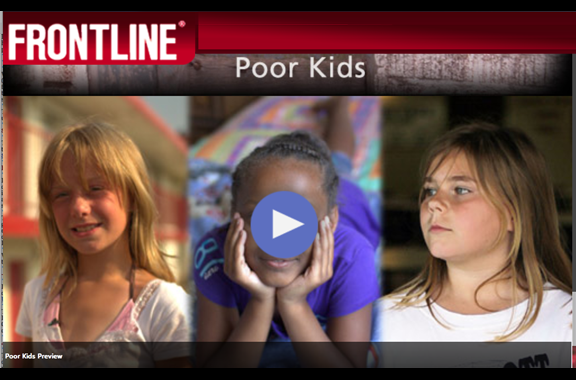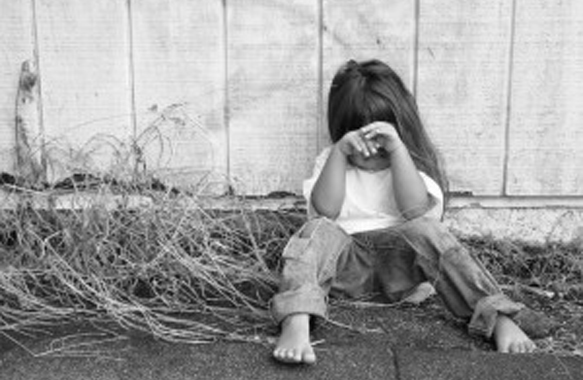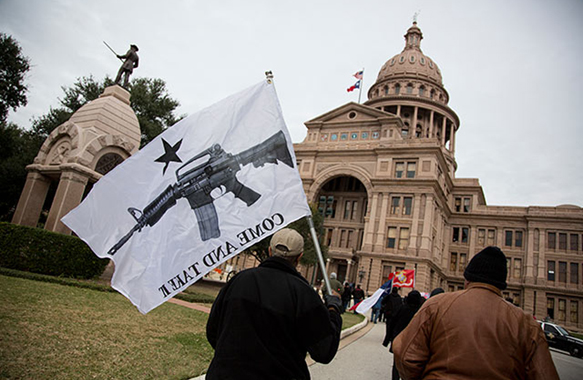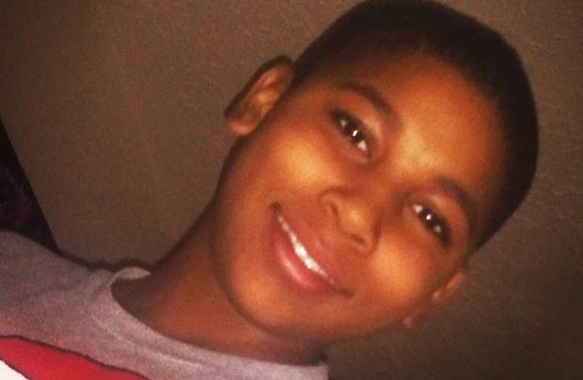Poor Kids | FRONTLINE | PBS Originally Published at Frontline. Public Broadcast Services.
What does it mean to grow up poor in America? In Poor Kids, airing tonight at 10 pm on PBS (check local listings), FRONTLINE follows several of the more than 13 million children in poverty for a glimpse at what life is like for a child in need. There is the near-constant hunger, the stress that comes from watching a parent struggle, and oftentimes, days and weeks spent living in a shelter or bouncing from motel to motel.
The preview above introduces the children featured in tonight’s film, while the figures below underscore many of the challenges facing all of the children living in poverty.
$23,050
The federal poverty guideline for a family of four is $23,050, up from $20,650 before the start of the recession. Today’s poverty guidelines compare with a median household income in the U.S. of $50,054.
$Between 13.4 and 16.5 million
Determining the exact number of children living in poverty can depend on what Census calculation you go by. More than 16 million children, or roughly one in five, were living in poverty in 2011, according to the U.S. Census Bureau’s official poverty measure (pdf). That is higher than any other age group. Among 18- to 64-year-olds, the poverty rate was 13.7 percent, while among seniors the rate was 8.7 percent.
The Census Bureau’s official figures fail to paint a complete picture, though. The formula the government uses to calculate the poverty rate was designed in the 1960s, and does not account for expenses that are necessary to even hold a job — such as transportation costs and child care. Nor does the formula account for government programs for the needy, such as food stamps and the Earned Income Tax Credit.
When the Census Bureau factors in (pdf) those types of variables in a new experimental formula the number of children found to be living in poverty falls to 13.4 million.
$- $5 billion
Despite the safety net’s record of lifting children out of poverty, the amount of federal spending on children in 2011 dropped from $450 billion to $445 billion, according to an analysis from The Urban Institute (pdf).
The study accounted for spending on programs such as Medicaid and the Children’s Health Insurance Program, and tax expenditures like the Earned Income Tax Credit and the Child Tax Credit. In all, the decline marked the first time that spending on children fell since the 1980s, and came in a year when total federal spending rose to $3.6 trillion from $3.52 trillion.
$47.6 percent
The nation’s poorest kids primarily live in households headed by a single female (pdf). Nearly half of all children with a single mother — 47.6 percent — live in poverty. Indeed, the children of single mothers experience poverty at a rate that is more than four times higher than kids in married-couple families.
$38.2 percent
Black children are more likely to live in poverty than children of any other race. The poverty rate among black children is 38.2 percent (pdf), more than twice as high as the rate among whites. The poverty rate for Hispanic children is 32.3 percent.
$24
Twenty-four states and the District of Columbia have poverty rates higher than the national average (pdf) of 15 percent, with the majority of the nation’s poor situated in the south. With a rate of 22.6 percent, Mississippi had the highest proportion of residents below the poverty line. At 8.8 percent, New Hampshire had the lowest. In Iowa and Illinois, where Poor Kids was filmed, the poverty rate is 12.8 percent and 15 percent, respectively.
$45 percent
The longer a child lives in poverty, the tougher it can be for them to climb out later in life. According to an analysis (pdf) by Columbia University’s National Center for Children in Poverty, 45 percent of people who spent at least half of their childhood in poverty were poor at age 35. Among those who spent less than half of their childhood in poverty, just 8 percent were poor at age 35.
$3
Only three other countries in the developed world have a higher child poverty rate (pdf) than the U.S., according to the Organization for Economic Cooperation and Development. Mexico leads all nations with a rate of 25.79, followed by Chile (23.95), Turkey (23.46), and the U.S. (21.63).
Watch Poor Kids Preview on PBS. See more from FRONTLINE.












Leave A Comment